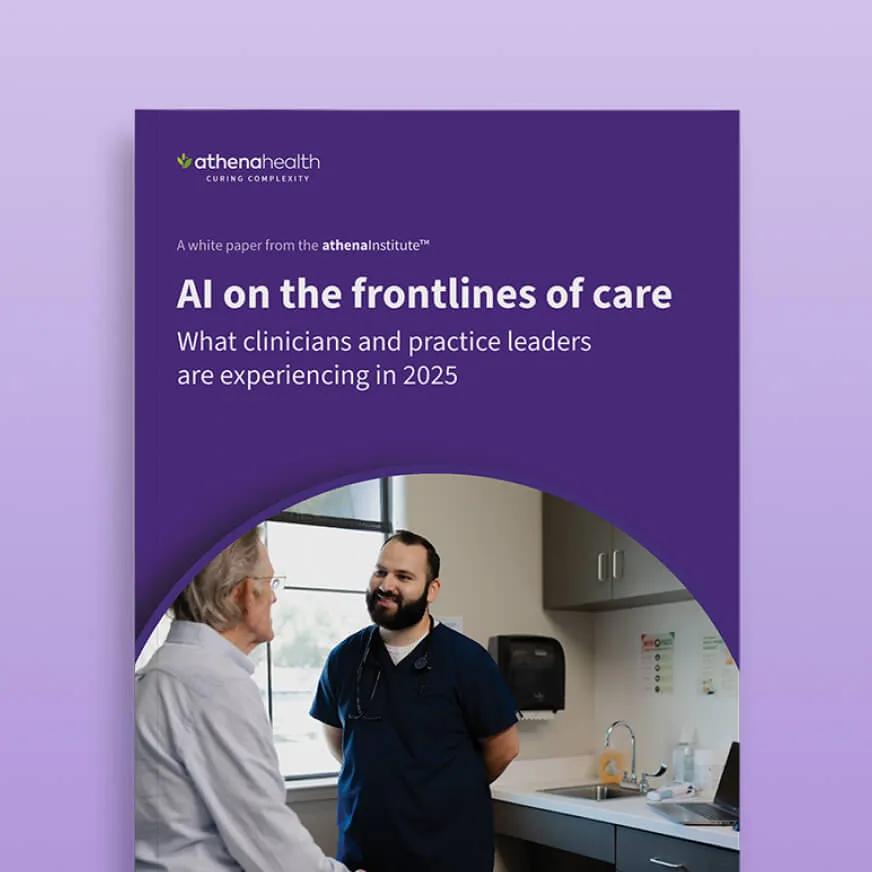The growing use of ambient scribes in clinical documentation
Generative AI is quickly becoming one of the most influential technologies in healthcare. The promise is simple yet profound: assist clinicians with repetitive, more mundane tasks so they can focus on patient care.
One of the clearest examples of generative AI use in healthcare tech is clinical documentation. Gen AI tools, especially ambient tools embedded within AI-native electronic health records (EHRs) are reshaping how clinicians capture the story of a patient visit. Done well, these AI tools not only speed up charting but also restore the human connection in the exam room by keeping attention on the patient.
Successfully introducing AI clinical notes into your practice
Clinical documentation has always been a balancing act, and a common pain point since the widespread adoption of EHRs. Providers want to be fully present with patients, but capturing accurate notes often means either splitting attention during the visit or catching up on notes later.
Like any emerging technology, ambient AI scribes require both thoughtful use and flexibility as they are deployed. Some clinicians have raised important questions about healthcare AI accuracy, privacy, and consent. Others note that technical hiccups or unclear speech can occasionally lead to corrections after the visit or manual rework. These are real considerations, and they highlight why change enablement matters.
AI-powered ambient clinical documentation tools are already helping to ease that burden. Functioning like a medical assistant or scribe, these tools can help clinicians stay focused on the person in front of them instead of the keyboard.
When used intentionally, ambient notetaking tools can support a more natural exam, reduce pajama-time documentation, and create cleaner, more complete records. To maximize the benefits of AI and to maintain trust, accuracy, and compliance in clinical documentation, physicians can look to these best practices to help them consider their appetite for AI tools in their workflows and how to thoughtfully implement them.
Best practices for using generative AI in clinical documentation
To get the most of generative AI scribe tools, it helps to take a mindful approach that embraces the technology’s strengths and the nuances of patient care:
1. Leverage training to the fullest
Getting started with generative AI in your EHR doesn’t have to feel overwhelming. Some vendors offer onboardings and onsite training for generative AI tools to help familiarize clinicians with the platforms and use cases and offer the opportunity to have any questions answered.
At athenahealth, we’re building a support system that helps clinicians discover new efficiencies and build trust in the platform:
- Live webinars for real-time learning and Q&A with experts
- On-demand guides and videos you can revisit anytime
- Peer communities to share tips and workflows across specialties
- Personal success managers who tailor guidance to your practice
- In-app nudges that surface workflow optimizations right when you need them.
2. Discuss the AI tool with the patient
Patients are adjusting to the new rhythm of the AI-powered visit as well, and transparency builds trust. Before using ambient tools, clearly explain to patients how the technology works, what information will be recorded, and how it will be used. Obtaining explicit patient permission is legally required but also helps reassure patients that their privacy is paramount. A simple, empathetic explanation can help foster a collaborative atmosphere and more engaged conversation.
3. Embrace a patient-centric bedside manner
One of the chief benefits of generative AI for clinical documentation is allowing practitioners to focus on the human connection during the exam. Because ambient tools work quietly in the background, patients experience a visit that feels more like a true conversation and less like a data-entry exercise. Clinicians can stay present by maintaining eye contact, engaging in active listening, and showing empathy, ensuring patients feel heard, respected, and supported.
4. Keep your device nearby and ready
One change that using ambient clinical documentation tools can require is having your phone within easy reach during a patient visit. Ambient tools rely on clear audio input to generate accurate notes, so positioning the device close enough to capture the conversation is key. It’s a small but crucial adjustment that also makes it easier to pause or resume recordings as needed without disrupting the encounter. Make sure the phone is on a stable surface and that the speakers are not obstructed to obtain the best audio quality.
5. Know when to pause and resume recordings
Not every moment in a clinical encounter needs to be recorded. Pausing the recording can help protect privacy and build trust, especially when discussing sensitive topics or after the clinical exam has completed. The ambient offerings in athenaOne® offer intuitive controls to pause and resume, including traditional voice dictation post-visit. Exploring and practicing with these features helps clinicians use them more naturally and effectively.
6. Speak clearly and guide the model
Generative AI models perform best when they have clear, specific input. Clinicians should aim to speak naturally but also intentionally to help the system accurately capture the clinical picture. That doesn’t mean abandoning your normal style – many AI models are trained in medical language and tuned for specific specialties – but it does mean being mindful of how you verbalize findings, clinical reasoning and patient responses. For example, when documenting a post-surgical knee exam, saying aloud what you observe about ligaments, range of motion, or therapy progress helps ensure the AI documentation tool captures those details faithfully.
Over time, clinicians also learn how their AI model interprets different phrasing – and the model learns from continued clinical use – the physician and AI assistant adjust together to get the best output. With tools like athenahealth’s Ambient Notes, clinicians can even choose the ambient model that feels most natural for their specialty and workflow.
7. Review and edit notes before finalizing
Ambient AI tools can take a lot of weight out of documentation, but it’s not meant to replace a clinician’s judgment. The draft notes ambient tools produce are a strong starting point that need the expert eye of the person who knows the patient best. Taking a moment to review the generated notes before finalizing and closing the encounter helps ensure accuracy, completeness, and compliance.
Working through each of the above best practices should help reduce the amount of time spent documenting after hours, but ultimately, it’s the clinician who confirms that a clinical note appropriately reflects the patient encounter.
Ambient AI tools are designed to get smarter over time as they learn from use and adapt to different workflows. Still, the nuances of patient care and clinical judgment will always require a clinician’s expert eye. By pairing AI efficiency with human expertise, clinicians can produce high-quality documentation that supports better patient outcomes.
When used intentionally, ambient notetaking tools can support a more natural exam, reduce pajama-time documentation, and create cleaner, more complete records
Embracing AI responsibly with athenahealth
Generative AI tools housed in an AI-native EHR represent a powerful step forward in healthcare documentation. Recent studies have shown clinicians using ambient technology spent 20.4% less time in notes per appointment and had a 9.3% greater same-day appointment closure1.
By following these best practices, clinicians can harness these innovations safely and effectively.
More time for patient care
One of the most exciting benefits of ambient AI documentation is the potential to free clinicians from the keyboard and screen. This shift aligns with athenahealth’s commitment to how AI innovation can promote connectivity and patient engagement. When technology handles the administrative load, clinicians can reconnect with the human side of medicine, enhancing the overall care experience.
At athenahealth, we support clinicians in adopting technology that empowers rather than overwhelms. If you’re considering integrating ambient AI tools into your practice, explore our resources and training to ensure a smooth, compliant transition that benefits both providers and patients.













